Albert Edelfelt
Albert Gustaf Aristides Edelfelt (21 July 1854 – 18 August 1905) was a Finnish painter noted for his naturalistic style and Realist approach to art.[1] He lived in the Grand Duchy of Finland and made Finnish culture visible abroad, before Finland gained full independence.[2]
Albert Edelfelt | |
|---|---|
 Portrait of Albert Edelfelt, Pascal Dagnan-Bouveret, 1887 | |
| Born | Albert Gustaf Aristides Edelfelt 21 July 1854 |
| Died | 18 August 1905 (aged 51) Porvoo, Grand Duchy of Finland |
| Nationality | Finnish |
| Education | Member Academy of Arts (1881) Full Member Academy of Arts (1895) |
| Alma mater | École Nationale des Beaux-Arts |
| Known for | Painting |
| Movement | Realism |
| Spouse(s) | Baroness Ellan de la Chapelle |
Biography
Edelfelt was born 1854 in Porvoo, son of Swedish-speaking Finns Carl Albert Edelfelt (1818–1869), an architect, and Alexandra Edelfelt, née Brandt (1833–1901).[3] His father died when he was still young, and his mother had to raise him and his younger siblings alone compounded by financial difficulties. He was very close with his mother throughout his life.[4]
 Carl Albert Edelfelt, 1883, posthumous painting of his father
Carl Albert Edelfelt, 1883, posthumous painting of his father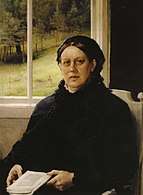 Alexandra Edelfelt, 1883, his mother
Alexandra Edelfelt, 1883, his mother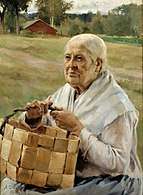 Old Woman with a Splint Basket, 1882, the Edelfelts' trusted maid and Albert's old nanny Fredrika Snygg
Old Woman with a Splint Basket, 1882, the Edelfelts' trusted maid and Albert's old nanny Fredrika Snygg
He began his formal studies of art in 1869 at the Drawing School of the Finnish Art Society and continued as a student of Adolf von Becker (1871–73). He studied history painting at the Antwerp Academy of Art (1873–74) before becoming a pupil of Jean-Léon Gérôme at the École Nationale des Beaux-Arts in Paris (1874–78). He sent his mother hundreds of letters when he was away.[4] In Paris, he shared a studio with the American Julian Alden Weir, who introduced him to John Singer Sargent. Later he studied at Saint Petersburg (1881–82). He had romantic relationships with numerous women.[2][4] He married Baroness Anna Elise "Ellan" de la Chapelle in 1888,[4] and the same year they had one child, Erik.[5] Albert died from heart failure in 1905.[6] Erik also died not long afterwards in 1910.[6][7]
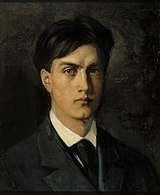 Self-portrait, 1874
Self-portrait, 1874 Sophie Manzey, 1880, Edelfelt's fiancée for a short while
Sophie Manzey, 1880, Edelfelt's fiancée for a short while_1883.jpg) The Parisienne, 1883, Virginie as the model
The Parisienne, 1883, Virginie as the model Self-portrait, c. 1887–90
Self-portrait, c. 1887–90 The Artist's Son Erik in a Pram, 1889
The Artist's Son Erik in a Pram, 1889 Portrait of the Artist's Wife Ellan Edelfelt, 1896
Portrait of the Artist's Wife Ellan Edelfelt, 1896 Self-portrait, 1904
Self-portrait, 1904 Erik Edelfelt in sickbed, 1905
Erik Edelfelt in sickbed, 1905
Career

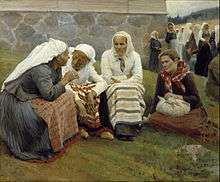

Edelfelt was one of the first Finnish artists to achieve international fame. He enjoyed considerable success in Paris, including a gold medal at the Paris Universal Exposition of 1889. His painted portraits of many famous people, including Louis Pasteur, Aino Ackté, and the Russian imperial family.[2]
In Finland, he was one of the founders of the Realist art movement in Finland. He influenced several younger Finnish painters and helped fellow Finnish artists such as Akseli Gallen-Kallela and Gunnar Berndtson to make their breakthrough in Paris. Among his students was Léon Bakst. The painting of Louis Pasteur won him the Legion of Honour in 1886 at the exhibition at the Paris Salon.[8]
Edelfelt admired the poet Johan Ludvig Runeberg, who was a friend of the family. The company of Runeberg had a lasting impact on Edelfelt, who from time to time turned to scenes from Finnish history in his paintings. Edelfelt went on to illustrate Runeberg's epic poem The Tales of Ensign Stål.
Pasteur
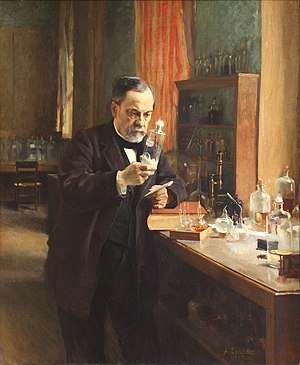
Edelfelt's history also includes his involvement and friendship with renowned French biologist, microbiologist, and chemist, Louis Pasteur. One of Edelfelt's most important paintings is his portrait of Pasteur. Edelfelt's letters to his mother, only recently discovered and written in Swedish, reveals evidence of Edelfelt's knowledge and work with Pasteur, stating Pasteur's working habits and traits of personality.[9]
This 1885 portrait of Louis Pasteur is the most reproduced image of the scientist himself. It is the most popular portrait because it is unlike the many other typical portraits of Pasteur; where he is sitting plainly. This specific portrait paints him engaging with his environment and using the modern-day tools of his time. Pasteur actively involved himself, working with Edelfelt, in the creation of this painting. This portrait painted by Edelfelt impacted Pasteur's career as it painted his reputation towards the public positively. Depicting Pasteur in the midst of his works brought out aspects of himself and his work that the public would not see otherwise.[9][10]
Painting Style

Edelfelt spent time in Antwerp and Paris, where he learned the practice of En Plein Air. He had come to a liking of En Plein Air because it was noticeable that illustrating contemporary reality rather than historical scenes were becoming popular during that time period.[11] He took on a focus towards naturalism and his paintings gave a direct reflection of the Finnish countryside and lifestyle.
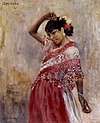
In April and May of 1881, Edelfelt spent five weeks in Spain where he learned many new aspects of art and studied the phenomenon called espagnolisme, which is the impact that Spanish influences had on France starting from the 1830s. In Spain, Edelfelt also gained a deeper grasp of Gypsy culture and Orientalism which had always interested him. His most important picture from Granada is Gitana Dancing I, a genre portrait of a dancing Gypsy girl.[12]
Edelfelt also dabbled in religious painting, creating biblical scenes revolving around his comfort in the Finnish landscape. This can be easily interpreted in his 1890 painting, Christ and Mary Magdalene. Edelfelt also had a successful career as an illustrator and portraitist.
Legacy
Albert Edelfelt was selected as the main motif on a Finnish commemorative coin celebrating the 150th anniversary of his birth, the €100 Albert Edelfelt and painting commemorative coin, minted in 2004. The reverse shows an embossed face of the artist.[13]
Gallery
 Queen Blanche, 1877
Queen Blanche, 1877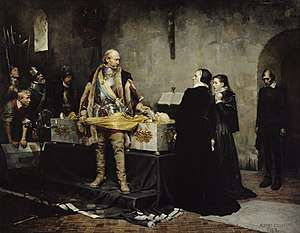
.jpg) Good Friends (Portrait of the Artist's Sister Bertha Edelfelt), 1881
Good Friends (Portrait of the Artist's Sister Bertha Edelfelt), 1881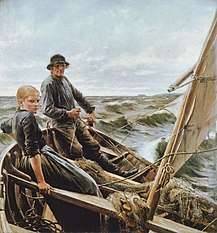 At sea, 1883
At sea, 1883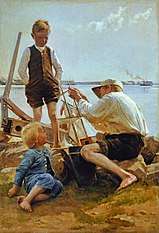 Shipbuilders, 1886
Shipbuilders, 1886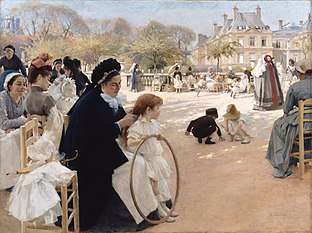 The Luxembourg Gardens, Paris, 1887
The Luxembourg Gardens, Paris, 1887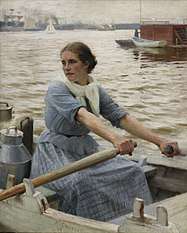 La laitière, 1889
La laitière, 1889_1889.jpg) At the gate (Village of Porras), 1889
At the gate (Village of Porras), 1889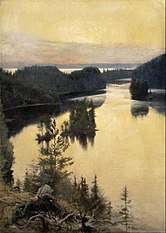 Kaukola Ridge at Sunset, 1889–90
Kaukola Ridge at Sunset, 1889–90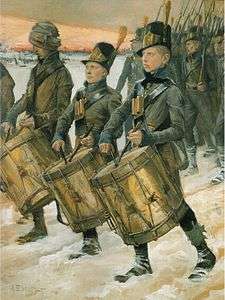
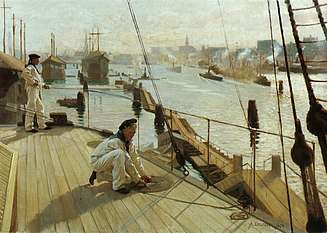 From the port of Copenhagen II, 1890
From the port of Copenhagen II, 1890.jpg) Laundresses, 1893
Laundresses, 1893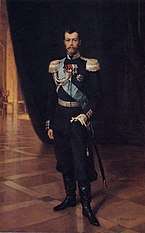 Portrait of Nicholas II, 1896
Portrait of Nicholas II, 1896 Portrait of Aino Ackté, 1901
Portrait of Aino Ackté, 1901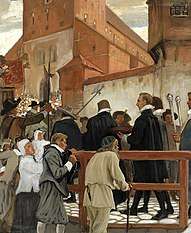 Inauguration of the Academy of Turku Part 1, 1904
Inauguration of the Academy of Turku Part 1, 1904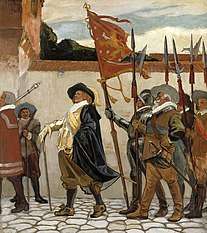 Inauguration of the Academy of Turku Part 2, 1904
Inauguration of the Academy of Turku Part 2, 1904 Inauguration of the Academy of Turku Part 3, 1904
Inauguration of the Academy of Turku Part 3, 1904
 Aleksis Kivi, 1873, almost certainly by Edelfelt
Aleksis Kivi, 1873, almost certainly by Edelfelt Mikael Agricola, 19th century
Mikael Agricola, 19th century Burned village, 1879
Burned village, 1879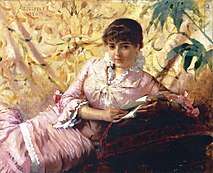 Reading Parisienne, 1880
Reading Parisienne, 1880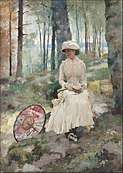 Under the Birches, 1881
Under the Birches, 1881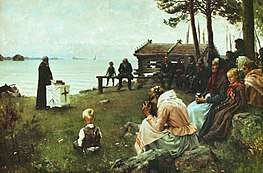 Divine Service in the Uusimaa Archipelago, 1881
Divine Service in the Uusimaa Archipelago, 1881.jpg) Boris Vladimirovich and Kirill Vladimirovich, 1881
Boris Vladimirovich and Kirill Vladimirovich, 1881.jpg) Vladimir Alexandrovich, 1881
Vladimir Alexandrovich, 1881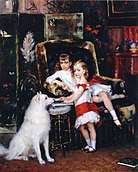 Michael Alexandrovich and Xenia Alexandrovna, 1882
Michael Alexandrovich and Xenia Alexandrovna, 1882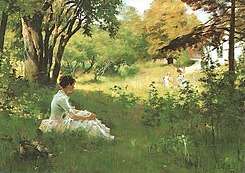 Summer, 1883
Summer, 1883 Summer Evening at Hammar's Repair Yard, 1885
Summer Evening at Hammar's Repair Yard, 1885.jpg) The Nursery, 1885
The Nursery, 1885.jpg) The Boys’ Workhouse, Helsinki, 1885
The Boys’ Workhouse, Helsinki, 1885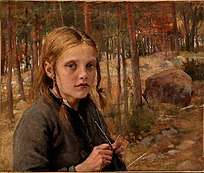 A Girl Knitting A Sock, 1886
A Girl Knitting A Sock, 1886 Woman and Parasol, 1886
Woman and Parasol, 1886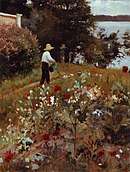 In the garden at Haikko, 1887
In the garden at Haikko, 1887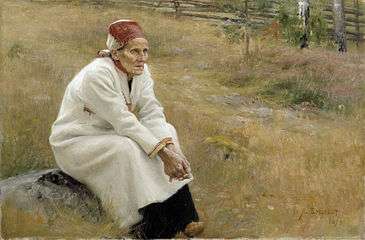 Larin Paraske, 1893
Larin Paraske, 1893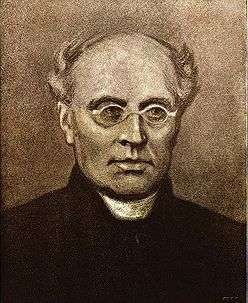 J.L. Runeberg, 1893
J.L. Runeberg, 1893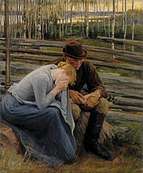 Sorrow, Variation of the Illustration for the Poem At the Fair of Vernamo, 1894
Sorrow, Variation of the Illustration for the Poem At the Fair of Vernamo, 1894 In the Outer Archipelago, 1898
In the Outer Archipelago, 1898_-_Nationalmuseum_-_18677.tif.jpg) Jesus Washing the Feet of his Disciples, 1898
Jesus Washing the Feet of his Disciples, 1898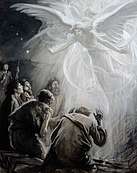 The Revelation of The Angels to The Shepherds, 1899
The Revelation of The Angels to The Shepherds, 1899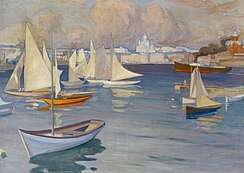 The Nyländska Jaktklubben Harbour in Helsinki, 1899
The Nyländska Jaktklubben Harbour in Helsinki, 1899
See also
References
- "Albert Edelfelt". artrenewal.org. Retrieved April 2, 2015.
- Reitala, Aimo (1997). "Edelfelt, Albert (1854 - 1905)". 100 Faces from Finland – a Biographical Kaleidoscope. Biographical Centre of the Finnish Literature Society. Retrieved 4 February 2017.
- Stavén, Amanda (19 April 2013). "Albert Edelfelt maalasi kansaa, valoa ja historiaa". Yle. Retrieved 16 May 2020.
- Sommar, Heidi (22 July 2016). "Albert Edelfeltin elämän tärkein nainen oli äiti". Yle. Retrieved 16 May 2020.
- "Albert Edelfelt, master of plein air". finland.fi. Retrieved April 2, 2015.
- Aimo, Reitala. "Edelfelt, Albert (1854 - 1905)". National Biography of Finland. Translated by Fletcher Roderick. Retrieved 8 May 2020.
- Reitala, Aimo (15 March 2015). "Edelfelt, Albert (1854 - 1905)". Kansallisbiografia (in Finnish). Retrieved 12 May 2020.
- "Louis Pasteur Albert Edelfelt". musee-orsay.fr. Retrieved April 2, 2015.
- Weisberg, R.E., & Hansen, B. (2015). "Collaboration of Art and Science in Albert Edelfelt's Portrait of Louis Pasteur: The Making of an Enduring Medical Icon". Bulletin of the History of Medicine. 89 (1): 59–91. doi:10.1353/bhm.2015.000.
- "Louis Pasteur Albert Edelfelt". musee-orsay.fr. Retrieved April 2, 2015.
- Utti, Otto (November 2004). "ALBERT EDELFELT, MASTER OF PLEIN AIR". This is Finland: Arts and Culture. Retrieved December 10, 2019.
- Lundstrom, Marie-Sophie (2006). "A Romantic in Spain: The Finnish Nineteenth-Century Painter Albert Edelfelt's Andalusian Dream". Journal of Intercultural Studies. 27:3, 331-348: 331–348. doi:10.1080/07256860600779311.
- "-Painters I should have known about". articlesandtexticles.co.uk. Archived from the original on April 2, 2015. Retrieved April 2, 2015.
External links
| Wikimedia Commons has media related to Albert Edelfelt. |
- (in English) Albert Edelfelt Studio Museum (Artist's Studio Museum Network)